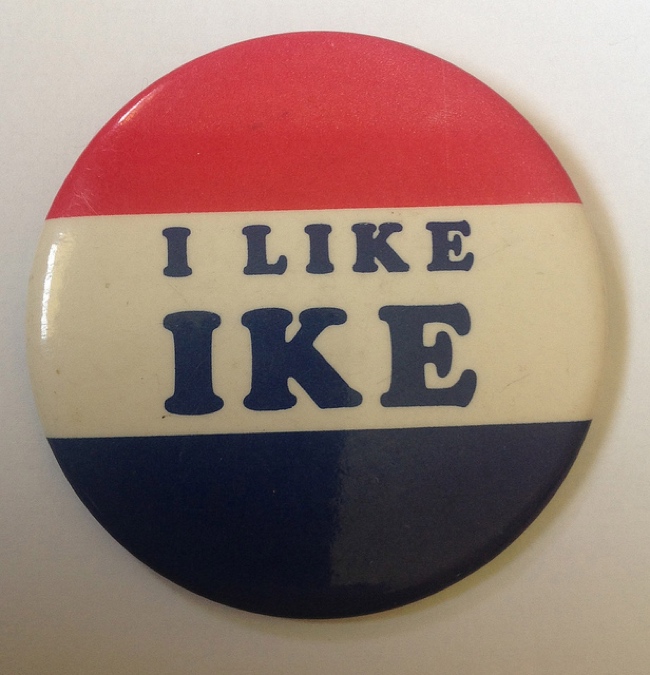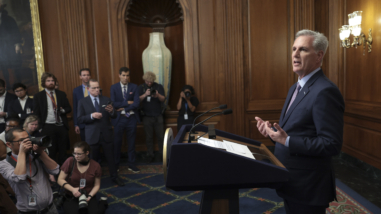State-of-the-art “Like” Button, Circa 1952. (Photo Credit: Flickr User Mpls55408, licensed under CC BY NC 2.0)
Spoiler alert: The campaigns of the future are not going to look like the campaigns of the past. Just as the introduction of television changed the door-to-door game decades ago, so too is the rise of the Internet and the ad-targeting available through services like TiVo changing the TV ad game that has dominated in recent years. And with fewer people watching commercials,the importance of social media companies will only expand.
That was my biggest takeaway from a discussion I attended late last month exploring the effect of changing technology on political campaigns. Sponsored by the Democracy Fund and hosted at Stanford Universty by Law Professor Nate Persily, alongside Heather Smith, the former Rock the Vote President, and Ben Ginsberg, former national counsel to both the Republican Governors Association and multiple presidential campaigns, it was a veritable who’s who of the political campaign world. Participants included Ann Ravel, Chair of the Federal Elections Commission, as well as several other commissioners from the FEC and FCC; the founders of both Change.org and Brigade Media; representatives from Google, Facebook, Twitter, and Tumblr; the head of Catalist, the self-styled “data utility” for progressive organizations; representatives from the Republican National Convention, and the New Organizing Institute; and academics from Harvard, Stanford, UNC Chapel Hill, and others. And of course some of us funders.
The day was divided into four sessions, looking at:
1. Campaign Communications
2. Voter Engagement and Mobilization
3. Campaign Fundraising
4. Campaign Finance Policy
The first session on “The Future of Campaign Communications” explored how new technologies will impact the prevelance of television ads, and the costs of campaign. The group’s best guess was that, today, only about 3% of campaign ad dollars are spent on digital – maybe more in presidential elections. The bulk is still spent on TV (though of course TV doesn’t play a big role in less competitive races, and is not a factor at all downballot).
As outreach moves to the internet, how will new microtargeting capabilities affect campaigns? The biggest questions were around truthiness and tone.
While broadcast communications make it harder to lie, microtargeting makes misinformation much easier to propogate. But of course both journalists and political opponents are highly incentivized to detect others’ mistruths. And Facebook coders are working on algorithms to validate statements’ authenticy. The key may lie in whether or not outsiders can see what’s going on. The room was less worried about tone on platforms like Facebook that don’t allow for anonymity. And incentives for positive play also exist at the campaign level—a main driver for placing ads on Facebook is the “propensity to share” (PTS), and PTS has proven to be better when ads are positive.
The second session explored “The Future of Voter Mobilization and Engagement.” Much here has also changed, though in ways I think most of us are familiar with. Centralization of data services within groups like Catalist has had a big impact—no more mom-and-pop data vendors. Today’s door-to-door canvassers can access a wealth of data about their targets, and input new information as they go.
One thing here remained clear: Campaigns will continue to target the most likely, most partisan voters. Participants agreed that “foundations must do the harder work” of encouraging less partisan, less engaged citizens (no matter their voting preferences) to take part in elections.
The third sessions moved on to explore “The Future of Campaign Fundraising,” looking at questions around how tech advances will alter the methods, tone, and level of participation in campaign financing.
New tech has surely made it easier to give, leading to a higher percentage of people contributing to campaigns. That said, it remains a small group—a universe of only about ten million donors. And a higher and higher percentage of the overall total is coming from the wealthiest 0.01%. In the early 1980s, that group accounted for 15% of the total. Now it’s closer to 40%.
The day concluded with a panel on “Public Policy and the Campaign of the Future” looking at campaign regulations going forward. Here the lawyers in the room conceded that the “rules have become so complicated that even the top lawyers wouldn’t get all the rules right on a test.” Which didn’t make me feel any better.
From this session, two core questions arose:
1. How powerful will the parties be? They were already weakened by McCain-Feingold, and now more and more groups like Catalist are taking over traditional party roles. That said, parties remain the gatekeepers of information and relationships that may be hard to replicate.
2. In the future, could the norms and algorithms that Google and Facebook come up with be more important than the rules from the FEC?
It was a fascinating day. The one thing that became clear to me is that our campaigns are undergoing a generational transition, and no one person or group has a monopoly on understanding what the future will look like.




